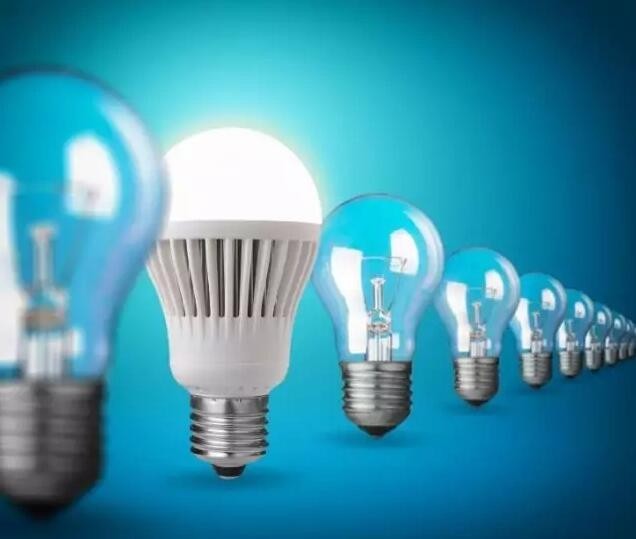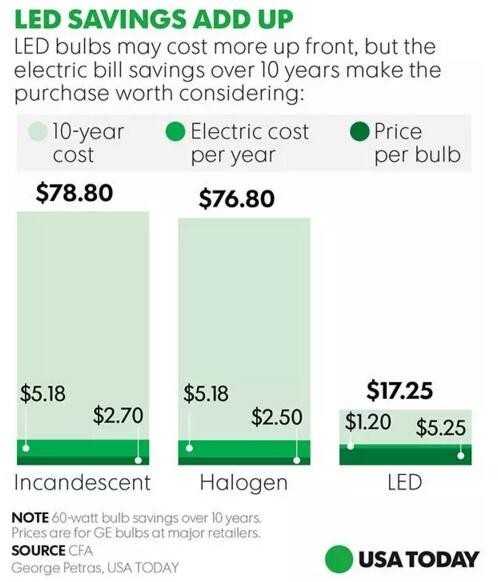How much can you save every family with LED bulbs for 10 years?
2019-09-05 13:54
The Consumers Association of America (CFA) recently conducted a consumer survey that focused on illuminating residential spaces and found that typical American homes used at least 20 bulbs at home.

CFA commissioned the Court of Final Appeal to conduct a survey based on 60 watt equivalent non-dimmable soft white LED bulbs sold by Lowes, Home Depot, Walmart, Costco, Target, Mega Supermarket, Safeway, CVS, Walgreens, Rite Aid, etc. Then, based on the annual electricity cost and the estimated life of a light bulb and the price of the bulb, a ten-year fee is obtained.
For example, a survey of 60-watt non-dimmable light bulbs found that the average 10-year cost of LEDs was $13.70, while the average 10-year cost of incandescent and halogen lamps was $69.49. Since the average household uses more than 20 bulbs, consumers now rely on incandescent and halogen lamps, saving more than $1,000 by switching to LEDs.
Melfar-Crawford, director of CFA Energy Programs, said: "By using LED bulbs, consumers can not only save money but also curb power usage, potentially reducing the need for expensive new power plants." "LED bulbs are consumers, electricity A win-win situation for the company and the environment," she added.
The price of LED bulbs has dropped by 85% in recent years, but some people still think it is expensive. According to an American family, there are at least 20 bulbs, about $5 a bulb, and replacing incandescent and halogen bulbs with LEDs would cost about $100 or more than twice that of a conventional incandescent or halogen bulb.
However, LED lamps have long service life, low energy consumption, higher efficiency, and more power savings, thus making up for additional costs.
In addition, CFA's price survey conducted in April found that most stores' 60-watt equivalent LED bulbs are now under $5. Energy-efficient LED bulbs on the Potomac River in Maryland tend to be cheaper because local power companies can implement rebates and allow manufacturers or retailers to subsidize to lower prices.
The main reason for the huge cost difference between different types of bulbs is related to the difference in power consumption. Incandescent/halogen lamps surveyed typically consume approximately $5 per year of electricity, while LED bulbs typically use approximately $1 per year. In fact, the life of incandescent/halogen bulbs is usually 1 to 2 years, and most LED bulbs have a life span of more than 10 years, which is part of the cost difference.

Mel Hall-Crawford said: "The LED bulbs are of good quality and last longer than traditional incandescent and halogen bulbs, and will eventually save money over time." "Enduring means consumers don't have to spend money to replace Light bulbs, don't worry about changing bulbs often.
“This is a convenient thing,” Hall-Crawford said. “If the luminaire is on a high place, you don’t have the trouble of replacing the bulb often.”
In addition, most people are accustomed to the warm yellow glow of incandescent and halogen bulbs. However, LED lights also have cooler shades of white and daylight tones as well as dimmable and non-dimmable varieties.
An LED (Light Emitting Diode) is a solid-state semiconductor device that converts electrical energy into visible light, which directly converts electricity into light. Stephen Brobeck, executive director of CFA, said: "This light bulb revolution is supported by the US federal government's energy efficiency standards." In 2000, the US Department of Energy (DOE) began to promote the development of LED technology.
In 2009, less than 400,000 LED lights were used in American homes. But by 2014, 78 million LED lights have been installed. Last year, DOE released a biennial forecast for solid-state lighting energy-saving applications for general lighting applications. The report focuses on the general lighting market in the United States. According to the report, in 2035, LED lights and luminaires are expected to account for 86% of the installation of lamps, covering all lighting categories.
However, a survey conducted by the Court of Final Appeal in June 2016 showed that only 36% of consumers knew about the benefits of high-efficiency LED luminaires.
“We are working hard to educate consumers,” Mel Hall-Crawford said. “Changes take time. We are getting people familiar with this new type of light bulb and they will save money.”
In addition to saving money, the use of LED lighting is also of great significance in terms of energy savings. LED lights emit less heat than traditional incandescent and halogen lamps. Mel Hall-Crawford said: "Incandescent and halogen bulbs waste energy by releasing more heat. In fact, incandescent bulbs emit about 90% of the energy as heat. LED lamps use 75-80% less energy."
According to the DOE, it is estimated that in 2035, the energy saved by LED lighting will reach 5.1 quads (Kude, energy unit, 1 Kurd is equivalent to 2400 million metric tons of oil), almost a year for 45 million households in the United States. The energy consumed is about 75% less energy than non-LED lighting fixtures.
Among the savings of 5.1 quads, there are two commercial lighting applications (lamps and patio lights), home applications (type A), and fixtures (directional lamps) for both home and commercial use in 2035. Smart connected lighting and other tunable lighting technologies will be an important key to energy savings, accounting for approximately 2.3 quads of total energy savings.
It is worth mentioning that the 8th Clean Energy Ministerial Meeting, the Global Lighting Challenge Forum, held on June 6th announced a new commitment of nearly 6 billion LED lighting products. Among them, 12 Chinese semiconductor lighting companies voluntarily submitted a commitment to sell 3.29 billion LED lamps and 5.77 million LED street lamps in the next two years (2017-2018).
According to these commitments, according to these commitments, the total energy savings in the next two years (2017-2018) will exceed 45 billion kWh, which is roughly half of the annual power generation of the Three Gorges Hydropower Station (93.5 billion kWh in 2016). These savings will reduce CO2 emissions by 40.5 million tons.
It is reported that lighting accounts for 13% of China's electricity consumption, accounting for about 15% of the world's total, and 5% of global greenhouse gas emissions are caused by lighting. Mark Radka, director of the UNEP Energy Division, pointed out that using high-efficiency and high-quality lighting systems can reduce energy consumption, and LED is a breakthrough technology.
Related News







